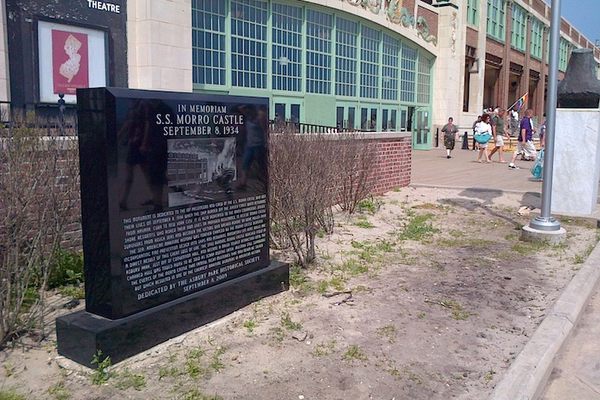When the Wreckage of a Horrific Ship Disaster Became a Tourist Destination
(photograph by Sarah Blake)
Each year in New Jersey, thousands of people walk the Asbury Park boardwalk, strolling between the now abandoned Asbury Park Casino and the famous Convention Hall. While the Hall gets its fair share of visitors, sitting next to it is a monument that escapes most of the visitor attention.
(photograph by Sarah Blake)
The black marble block situated next to Convention Hall is engraved with the image and story of the disaster that met the SS Morro Castle, a passenger cruise ship that, beginning on September 7, 1934, faced a string of tragedies that ended on the beaches of Asbury Park— taking 137 lives with it.
SS Morro Castle (via Library of Congress)
It was late into the evening on September 7, 1934, and the large cruise ship was cutting through the ocean making its way back to New York City, trying to outrun a brewing nor’easter. The SS Morro Castle was the star of the Ward Line Company, and since 1930 its weekly voyages from New York to Cuba brought its passengers temporarily out of the harsh realities of the Depression and gave them a week in the luxury and comfort of a tropical paradise. The crew entertained, the rum flowed freely, and regardless of their financial backgrounds on shore, everyone became royalty once they set foot on the polished wood decks. It was the vacation they would remember the rest of their lives.
However, this night was different for the Morro Castle. The parties were small and isolated with an air of melancholy attributed to far more than the end-of-vacation blues. On the bridge of the ship stood acting Captain William Warms whose demeanor reflected the trauma that had occurred only hours before. Just before the Captain’s Farewell Ball that evening, the beloved ship’s captain, Captain Robert Wilmott, had been found dead inside his cabin.
There was no immediate explanation as to the cause of death and it was quickly attributed to a heart attack. Control was assumed by Warms putting him in charge of guiding the ship back home through the bad weather. After the announcement of Wilmott’s death, the evening’s festivities were cancelled and passengers looked to their own cabins or small impromptu parties to bring their vacation to a close. Warms stood on the bridge unaware that the tragedies of the night were only just beginning for the SS Morro Castle.
SS Morro Castle burning at sea on September 8 (via Library of Congress)
It was approximately 2:45 am when Steward Daniel Campbell was approached by a passenger inside the Smoking Room asking if he smelled smoke. Assuming it was a wastebasket fire caused by a cigarette, Campbell set out to investigate and eventually found himself in the ship’s Writing Room where he saw smoke coming from a storage locker.
When Campbell opened the locker he found not a small fire, but an out-of-control blaze. Night watchman Arthur Pender had followed Campbell, and after seeing the fire quickly began trying to get other crew members to help extinguish it. Minutes later, unaware of what was happening in the Writing Room, another night watchman named Harold Foersch was entering the wheelhouse and pointing out to the officer on duty Clarence Hackney that there was smoke pouring out of one of the ship’s ventilators. While examining the smoke, Captain Warms entered the wheelhouse and told Hackney to investigate. In the lower decks of the ship, crew members and a few passengers already knew what Warms had just begun to understand: the SS Morro Castle was on fire.
The situation was hopeless from the moment it was discovered. Within 15 minutes, the ship was engulfed in flames with many people only being alerted by screams of panic. Many of the escape routes and lifeboats were inaccessible through the fire and hundreds of people scrambled on the decks looking for any sign of help. The crew was not trained to handle a fire and, seeing no other option, passengers jumped overboard leaving their fates to the violently thrashing ocean.
An SOS was not sent out until 3:25 am due to radio operator George White Rogers refusing to send a call without the official order from Warms, and it was nearly 4 am before nearby ships got to the smoldering wreck. What greeted the rescuers was an ocean of people both living and dead, and a glowing ship with some of the crew still aboard.
Hulk of the burned SS Morro Castle (via Wikimedia)
Warms had dropped the anchor after the fire cut all power, and amid the rescuing of survivors the anchor chain had to be manually cut with a saw before a towline could drag the wreck to shore. Hours later, the towline snapped, leaving the still-burning ship at the mercy of the ocean.
SS Morro Castle seen from the Asbury Park boardwalk (via 7seasvessels.com)
It was 7:34 pm on September 8 when the Morro Castle finally came to rest, beaching itself 200 feet off of Asbury Park, perfectly adjacent to Convention Hall. The ship became a magnet for people who wanted to see the doomed vessel and while bodies were still washing up along the New Jersey coast, signs were being posted and admission being collected to come see the wrecked Morro Castle.
The ship would remain there until the following March, when it finally was hauled away for scrap, leaving behind the memory of the disaster and the 137 lives that were lost on their vacation of a lifetime.
MONUMENT TO THE SS MORRO CASTLE DISASTER, Asbury Park, New Jersey




Follow us on Twitter to get the latest on the world's hidden wonders.
Like us on Facebook to get the latest on the world's hidden wonders.
Follow us on Twitter Like us on Facebook